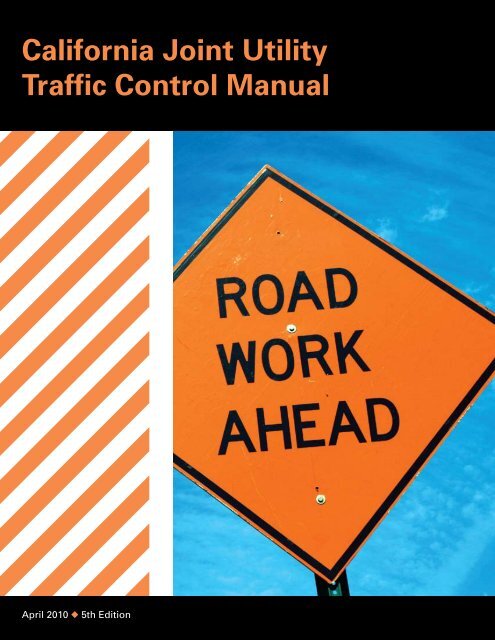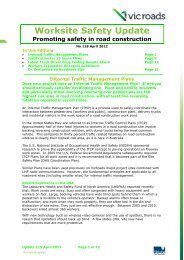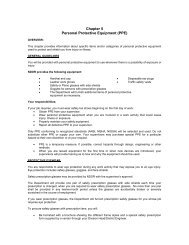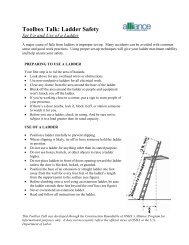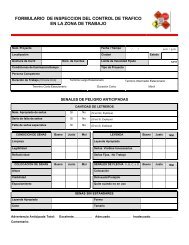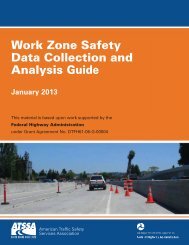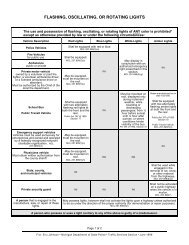California Joint Utility Traffic Control Manual - National Work Zone ...
California Joint Utility Traffic Control Manual - National Work Zone ...
California Joint Utility Traffic Control Manual - National Work Zone ...
You also want an ePaper? Increase the reach of your titles
YUMPU automatically turns print PDFs into web optimized ePapers that Google loves.
<strong>California</strong> <strong>Joint</strong> <strong>Utility</strong><br />
<strong>Traffic</strong> <strong>Control</strong> <strong>Manual</strong><br />
April 2010 ◆ 5th Edition
<strong>California</strong> <strong>Joint</strong> <strong>Utility</strong> <strong>Traffic</strong> <strong>Control</strong> <strong>Manual</strong><br />
TABLE OF CONTENTS<br />
ENDORSEMENTS........................................................................................................... 5<br />
INTRODUCTION TO THE FIFTH EDITION ................................................................ 7<br />
PUBLIC UTILITIES CODE............................................................................................. 9<br />
CALIFORNIA JOINT UTILITY TRAFFIC CONTROL MANUAL ........................... 10<br />
Fundamental Principles ......................................................................................... 10<br />
TEMPORARY TRAFFIC CONTROL (TTC) GENERAL/REFERENCE<br />
INFORMATION .............................................................................................................. 12<br />
Short Duration <strong>Work</strong> Operations ......................................................................... 12<br />
End of <strong>Work</strong> Period ................................................................................................. 13<br />
Night Operations ...................................................................................................... 14<br />
TTC Sign Recommendations ................................................................................ 14<br />
OPEN TRENCH Sign (C27(CA))......................................................................... 14<br />
FIGURE A – Use of C27 Open Trench Sign...................................................... 15<br />
Table A - Suggested Minimum Advance Warning Sign Spacing ................. 16<br />
Table B - Taper Length Criteria for Temporary <strong>Traffic</strong> <strong>Control</strong> <strong>Zone</strong>s .............. 16<br />
Table C - Formulas for Determining Taper Lengths ............................................ 16<br />
Table D – Buffer Space Table ................................................................................. 17<br />
Table E - Taper Length Criteria for Temporary <strong>Traffic</strong> <strong>Control</strong> zones............... 17<br />
Channelizing Devices ............................................................................................. 18<br />
Table F – Maximum Spacing of Channelizing Devices ....................................... 18<br />
Barricades.................................................................................................................. 19<br />
Arrow Panels............................................................................................................. 19<br />
Table G – Arrow Panel Table .................................................................................. 20<br />
Flagger Reference Information............................................................................. 20<br />
FLAGGING TRAFFIC ............................................................................................... 21<br />
REFERENCE SIGN CHART.................................................................................... 24<br />
1
<strong>California</strong> <strong>Joint</strong> <strong>Utility</strong> <strong>Traffic</strong> <strong>Control</strong> <strong>Manual</strong><br />
DRAWING LIST<br />
DRAWINGS SUBURBAN/RURAL SECTION<br />
Two Lane <strong>Traffic</strong> <strong>Control</strong> without Centerline……………………………….…..1<br />
<strong>Work</strong> in Center of Road (w/Centerline) – Two Lane <strong>Traffic</strong> <strong>Control</strong>…….….2<br />
<strong>Work</strong> in Center of Road (w/o Centerline) – Two Lane <strong>Traffic</strong> <strong>Control</strong>….…..3<br />
Midblock Half Street Closure – Flagger <strong>Control</strong>………………………………..4<br />
Single Lane Closure for One Way Street………………………………………..5<br />
Multi Lane Closure for One Way Street – Right Lanes Closed………………6<br />
Single Lane Closure – Right Lane using Left Turn Lane……………….…….7<br />
Left Turn Lane Closure – Midblock………….………………………...…………8<br />
Single Lane Closure – Right Lane…………………………………………….….9<br />
Shoulder Closure ….…….…..…………………………………………………….10<br />
Midblock Closure for One Direction of <strong>Traffic</strong>………………………………..11<br />
Midblock No. 1 Lane Closure…………………………………………………….12<br />
Midblock No. 1 Lane and Left Turn Lane Closure………...………………….13<br />
Midblock No. 1 Lanes and Left Turn Lane Closure…………………………..14<br />
Midblock No. 1 Lane Closures for Both Lanes of <strong>Traffic</strong>……………………15<br />
Midblock Half Street Closure – Using Left Turn Lane as Traveled Lane...16<br />
Multi Lane Closure – Right Lanes and Left Turn Lanes…………………….17<br />
Edge of Gutter Closure……………………………………………………………18<br />
Middle Lane Closure……………………………………………………………….19<br />
Multi Lane Closure – Right Lanes………………………………………….……20<br />
Midblock Closure of No. 2 Lane and Curb Lane…………………………...…21<br />
Multi Lane Closure – Left Lanes………………………………………..…….…22<br />
<strong>Work</strong> Beyond Intersection – Right Lane…….…………………….……….…..23<br />
<strong>Work</strong> Beyond Intersection – Left Lane…………………………….……….…..24<br />
<strong>Work</strong> Beyond Intersection – Right Side Single Thru Lane………………….25<br />
<strong>Work</strong> Beyond Intersection – Left Side Single Thru Lane………………..….26<br />
Left Turn Lane Closure – At Intersection………………………………………27<br />
2
<strong>California</strong> <strong>Joint</strong> <strong>Utility</strong> <strong>Traffic</strong> <strong>Control</strong> <strong>Manual</strong><br />
<strong>Work</strong> Within Intersection – Left Lane/Left Turn Lane………………………..28<br />
<strong>Work</strong> Within Intersection – Right Lane/Left Turn Lane……………………...29<br />
DRAWINGS URBAN SECTION<br />
Intersection <strong>Work</strong> – Right/Center………………………………………………..30<br />
Intersection <strong>Work</strong> – Right/Left……………………………………………...……31<br />
Beyond Intersection – Far Left…………………………………………………..32<br />
Intersection <strong>Work</strong> – Center……………………………………………………….33<br />
Intersection <strong>Work</strong> – Right…………………………………………………………34<br />
Intersection <strong>Work</strong> – Right…………………………………………………………35<br />
Intersection <strong>Work</strong> – Center….…………...……….………………………………36<br />
Intersection <strong>Work</strong> – Right/Center….…………….………………………………37<br />
Intersection <strong>Work</strong> – Right/Center…..……………………………………………38<br />
Intersection <strong>Work</strong> – Right…………………………………………………………39<br />
Intersection <strong>Work</strong> – Far Left/Right ….….………………………………………40<br />
Half Street Closure – Far Side…….………..……………………………………41<br />
Half Street Closure – Near Side…….……………………………………………42<br />
Full Street Closure – Two Way Street………..…………………………………43<br />
Full Street Closure – One Way Street…..………………………………………44<br />
Sidewalk Closure – Right/Center………………………………………………..45<br />
Sidewalk Closure…………………………………………………………………...46<br />
Sidewalk Closure…………………………………………………………………...47<br />
Sample <strong>Traffic</strong> Circulation Plan………………………………………………….48<br />
3
<strong>California</strong> <strong>Joint</strong> <strong>Utility</strong> <strong>Traffic</strong> <strong>Control</strong> <strong>Manual</strong><br />
The <strong>California</strong> <strong>Joint</strong> <strong>Utility</strong> <strong>Traffic</strong> <strong>Control</strong> <strong>Manual</strong> is a joint effort among members of<br />
the <strong>California</strong> Inter-<strong>Utility</strong> Coordinating Committee. The member logos below are<br />
proudly displayed as a sign of their support in developing safe working conditions for<br />
their employees as well as for the traveling public. We are a dedicated group who<br />
wants safety first. As you read through this manual, please keep in mind that safety is<br />
everyone’s business and it is up to each one of us to do our part in ensuring a safe<br />
work zone.<br />
4
<strong>California</strong> <strong>Joint</strong> <strong>Utility</strong> <strong>Traffic</strong> <strong>Control</strong> <strong>Manual</strong><br />
ENDORSEMENTS<br />
<strong>California</strong> Department of Transportation (Caltrans) has reviewed the <strong>California</strong> <strong>Joint</strong><br />
<strong>Utility</strong> <strong>Traffic</strong> <strong>Control</strong> <strong>Manual</strong> and finds it to be in conformance with the <strong>California</strong> <strong>Manual</strong><br />
on Uniform <strong>Traffic</strong> <strong>Control</strong> Devices for Streets and Highways (FHWA’s MUTCD 2003<br />
Revision 2, as amended for use in <strong>California</strong>) also called <strong>California</strong> MUTCD 2010 issued<br />
by Caltrans on January 21, 2010.<br />
Caltrans is not responsible for the content of this manual and it is up to the local<br />
jurisdiction to ensure the plans and traffic control being used are appropriate for the field<br />
conditions and work being performed. When working on State Highways in <strong>California</strong><br />
refer to the <strong>California</strong> MUTCD 2010 and use the existing encroachment permit<br />
processes.<br />
Gurinderpal (Johnny) Bhullar, P.E., T.E.<br />
Senior Transportation Engineer<br />
Editor, <strong>California</strong> MUTCD<br />
Office of Signs, Markings & External Support<br />
Caltrans, Division of <strong>Traffic</strong> Operations, MS-36<br />
1120 N St., Sacramento, CA 95814<br />
916-654-7312<br />
johnny.bhullar@dot.ca.gov<br />
I have been using the <strong>California</strong> <strong>Joint</strong> <strong>Utility</strong> <strong>Traffic</strong> <strong>Control</strong> <strong>Manual</strong> for more than 8 years<br />
because it has proven to be a sound resource for routine permit work within the public<br />
right of way. The modifications included in this edition ensure that safe work zones are<br />
properly set up to perform standard utility repairs and maintenance within the public right<br />
of way. This manual may help expedite the permitting process by notifying the<br />
jurisdictional agency exactly what traffic control will be used to successfully complete the<br />
permitted work.<br />
Nelson D. Nelson, P.E.<br />
City of Corona<br />
Assistant Public <strong>Work</strong>s Director/Assistant City Engineer<br />
The City of Corona is not responsible for the content of this manual and it is up to the<br />
local jurisdiction to ensure the plans and traffic control being used are appropriate for the<br />
field conditions and work being performed.<br />
5
<strong>California</strong> <strong>Joint</strong> <strong>Utility</strong> <strong>Traffic</strong> <strong>Control</strong> <strong>Manual</strong><br />
The City of Dana Point allows encroachment permit applicants (applicants), generally<br />
Contractors and <strong>Utility</strong> Companies, to use the <strong>California</strong> <strong>Joint</strong> <strong>Utility</strong> <strong>Traffic</strong> <strong>Control</strong><br />
<strong>Manual</strong>, among other publications via City Ordinance 14.01.220 Safety and Warning<br />
Devices Required. The guidelines and manuals noted in this ordinance are invaluable<br />
tools to applicants that need to accomplish work in City Streets. In a number of cases,<br />
these standard documents have helped these applicants in the City of Dana Point avoid<br />
expense in generating traffic control plans, as these plans specifically accommodate<br />
their needs, and provide for a safe working environment. The City will continue to allow<br />
these manuals/guidelines to be utilized to accomplish work in our rights-of-way. Of<br />
course, any Contractor or <strong>Utility</strong> Company doing work in any City street assumes all<br />
responsibility and liability.<br />
Matthew Sinacori, P.E.<br />
City Engineer<br />
City of Dana Point<br />
phone (949) 248-3574<br />
fax (949) 234-2826<br />
After reviewing the manual and its accompanying drawings I can completely endorse the<br />
use of the manual for routine utility work within Covina’s rights-of-way.<br />
Steve Henley<br />
City of Covina<br />
Public <strong>Work</strong>s Director<br />
The city of Claremont endorses the use of the (CJUTCM) manual.<br />
Craig Bradshaw<br />
City of Claremont<br />
Senior City Engineer<br />
6
<strong>California</strong> <strong>Joint</strong> <strong>Utility</strong> <strong>Traffic</strong> <strong>Control</strong> <strong>Manual</strong><br />
Introduction to the Fifth Edition<br />
This <strong>Manual</strong> is coordinated and prepared by the <strong>California</strong> <strong>Joint</strong> <strong>Utility</strong> <strong>Traffic</strong> <strong>Control</strong><br />
Committee. It provides the basic standards for the safe movement of traffic upon<br />
highways or streets in accordance with Section 21400 of the <strong>California</strong> Vehicle Code<br />
and the <strong>California</strong> <strong>Manual</strong> on Uniform <strong>Traffic</strong> <strong>Control</strong> Devices for Street and Highways<br />
2010 Edition. <strong>Traffic</strong> control includes safe protection for the public, motorist, cyclist,<br />
pedestrian and worker. It is the responsibility of the contractor or organization<br />
performing work on, or adjacent to, a roadway to install and maintain such devices which<br />
are necessary to provide safe passage for the traveling public through the work area and<br />
for the safety of the workers.<br />
This text is not intended to establish or create a legal standard. The criteria for the<br />
position, location, manner of installation, and the use of such signs, lights and devices<br />
are furnished solely for the purpose of information and guidance. This manual will be<br />
updated as required to conform to Federal and State guidelines. When working on State<br />
Highways in <strong>California</strong> refer to the <strong>California</strong> <strong>Manual</strong> on Uniform <strong>Traffic</strong> <strong>Control</strong> Devices<br />
for Streets and Highways 2010 Edition and use the existing encroachment permit<br />
processes.<br />
<strong>California</strong> <strong>Joint</strong> <strong>Utility</strong> <strong>Traffic</strong> <strong>Control</strong> Committee Members:<br />
Reed Reisner<br />
SCE --- Committee Chairman<br />
Patti Good<br />
SDG&E ® --- Committee Vice Chairman<br />
Louis Renner<br />
PG&E<br />
John Gilginas<br />
PG&E<br />
Mike Harriel<br />
Southern <strong>California</strong> Gas Company<br />
Mike Riley<br />
Verizon<br />
Oscar Escobar<br />
Verizon<br />
Kristin Maldonado<br />
Verizon<br />
Gail Dafun<br />
AT&T<br />
Dennis Buss SDG&E ®<br />
7
<strong>California</strong> <strong>Joint</strong> <strong>Utility</strong> <strong>Traffic</strong> <strong>Control</strong> <strong>Manual</strong><br />
Technical Review Team:<br />
I have reviewed the <strong>Manual</strong> prepared by the <strong>California</strong> <strong>Joint</strong> <strong>Utility</strong> <strong>Traffic</strong> <strong>Control</strong><br />
Committee and am pleased to endorse it.<br />
LOUIS RENNER, Certified Safety Professional Certification # 11510<br />
Board of Certified Safety Professionals (BCSP) 208 Burwash Avenue, Savoy, IL<br />
Phone: 415-973-7470, Fax: 415-973-1390, Email: LPR3@pge.com<br />
Pacific Gas and Electric Company. 77 Beale Street, Mail Code B23H Rm. 2854A<br />
San Francisco, CA 94105<br />
JOHN GILGINAS, Certified Safety Professional Certification # 18487<br />
BCSP 208 Burwash Avenue, Savoy, IL<br />
Phone: 415-973-2454, Fax: 415-973-1390, Email: JPGd@pge.com<br />
Pacific Gas & Electric Company. 77 Beale Street, Mail Code B23H Rm. 2882<br />
San Francisco, CA 94105<br />
PARDUMAN S. MARWAH, RCE # 25380 State of <strong>California</strong><br />
Phone: 909-274-1436, Fax: 909-274-1465, Email: marwahps@sce.com<br />
Southern <strong>California</strong> Edison Company. One Innovation Way.<br />
Pomona, CA 91768<br />
(For technical questions related to SCE work please contact Noe Bargas)<br />
NOE BARGAS, Engineer<br />
Phone: 909-274-1457, FAX: 909-274-1465, Email: noe.bargas@sce.com<br />
Southern <strong>California</strong> Edison Company. One Innovation Way.<br />
Pomona, CA 91768<br />
MIKE HARRIEL, Technical Supervisor<br />
Phone: 714-634-3278, Fax: 714-634-7287, Email: MHarriel@semprautilities.com<br />
Southern <strong>California</strong> Gas Company. 1919 S. State College Blvd, Mail Code SC8321<br />
Anaheim, CA 92806-6114<br />
MIKE RILEY, Outside Plant Network Engineering Manager, South Division<br />
Phone: 909-748-6650, Email: mike.riley@verizon.com<br />
Verizon. 1980 Orange Tree Ln., Suite 100<br />
Redlands, CA 92374<br />
OSCAR ESCOBAR, Outside Plant Network Engineering Manager, East Division<br />
Phone: 909-469-6351, Email: oscar.escobar@verizon.com<br />
Verizon. 1400 E. Phillips Blvd.<br />
Pomona, CA 91766<br />
KRISTIN MALDONADO, Outside Plant Network Engineering Section Manager, Tri-Valley District<br />
Phone: 951-925-5319 Email: kristin.m.maldonado@verizon.com<br />
Verizon. 150 S. Juanita St.<br />
Hemet, CA 92543<br />
BRIAN R. TODD, Outside Plant Engineer South C&E Region<br />
Phone: 714-666-5518, Fax: 714- 630-6617, Email: bt1469@att.com<br />
AT&T <strong>California</strong>. 1265 N. Van Buren St Floor Room 180<br />
Anaheim, CA 92807-1608<br />
JAIME BORRUEL, TCP Specialist<br />
Phone: 858.636.5589, Email: jborruel@semprautilities.com<br />
San Diego Gas & Electric ®<br />
8
<strong>California</strong> <strong>Joint</strong> <strong>Utility</strong> <strong>Traffic</strong> <strong>Control</strong> <strong>Manual</strong><br />
Public Utilities Code<br />
AT&T and Verizon as telephone utilities have been granted by the State the right to use<br />
public streets. This grant, known as the state franchise is found in Section 7901 of the<br />
<strong>California</strong> Public Utilities Code. Section 7901 provides that:<br />
“Telegraph or telephone corporations may construct lines of telegraph or telephone lines<br />
along and upon any public road or highway, along or across any of the waters or lands<br />
within this State, and may erect poles, posts piers, or abutments for supporting the<br />
insulators, wires, and other necessary fixtures of their lines, in such manner and at such<br />
points as not to incommode the public use of the road or highway or interrupt the<br />
navigation of the waters.”<br />
Many cities and counties have granted Southern <strong>California</strong> Edison, as an electric utility,<br />
San Diego Gas & Electric, as a gas and electric utility, Southern <strong>California</strong> Gas<br />
Company, as a gas utility, and Pacific Gas and Electric Company as an electric and gas<br />
utility the right to use public streets. These grants, known as the city or county<br />
franchises, are granted in accordance with: (1), the Broughton Act, set forth in Section<br />
6001, et seq. of the Public Utilities Code, or (2) the Franchise Act of 1937, set forth in<br />
Section 6201, et seq. of the Public Utilities Code.<br />
Illustrative of the franchise rights granted by counties and cities to public utilities, Section<br />
6265 of the Public Utilities Code provides that:<br />
“Every gas franchise granted pursuant to this chapter confers upon the grantee<br />
the right to use, or to lay and use, gas pipes and appurtenances for the purpose of<br />
transmitting and distributing oil or products thereof; every industrial gas<br />
franchise so granted confers upon the grantee the right to use, or lay and use<br />
industrial gas pipelines and appurtenances for the purpose of transmitting and<br />
distributing industrial gas;… and every electric franchise so granted confers upon<br />
the grantee thereof the right to use, or to construct and use, poles, wires or<br />
conduits and appurtenances for the purpose of transmitting and distributing<br />
electricity for all purposes, under, along, across, or upon the public streets, ways,<br />
alleys, and places as they now or hereafter exist within the municipality.”<br />
9
<strong>California</strong> <strong>Joint</strong> <strong>Utility</strong> <strong>Traffic</strong> <strong>Control</strong> <strong>Manual</strong><br />
<strong>California</strong> <strong>Joint</strong> <strong>Utility</strong> <strong>Traffic</strong> <strong>Control</strong> <strong>Manual</strong><br />
Fundamental Principles:<br />
The needs and control of all road users (motorists, bicyclists and pedestrians within the<br />
highway including persons with disabilities in accordance with the Americans with<br />
Disabilities Act of 1990 (ADA) Title II, Paragraph 35.130) through a temporary traffic<br />
control (TTC) zone shall be an essential part of highway construction, utility work,<br />
maintenance operations and the management of traffic incidents.<br />
Those using the roadway (motorists, bicyclists and pedestrians), worker safety at the job<br />
site and accessibility in TTC zones should be an integral part of every project initiated in<br />
the planning phase and continuing through design and construction. In a like fashion,<br />
maintenance and utility work should be planned and conducted with the safety and<br />
accessibility of all motorists, bicyclists, pedestrians (including those with disabilities) as<br />
well as the safety of those workers performing the work.<br />
NOTE: <strong>Work</strong> around a railroad or highway rail grade crossing will require early<br />
coordination with the railroad company prior to work planning.<br />
To provide safety for motorists, bicyclists, pedestrians, workers, enforcement/emergency<br />
officials and equipment at the job site, the following factors must be considered:<br />
1. Safety principles governing the design of permanent roadways and roadsides should<br />
also govern the design of temporary traffic control zones. The goal should be to<br />
route road users through such zones using roadway geometrics, roadway features<br />
and temporary traffic controls as nearly as possible comparable to those for normal<br />
highway/traffic situations.<br />
2. A temporary traffic control plan should be prepared and understood by all<br />
responsible parties before the site is occupied. Any changes in the TTC plan shall<br />
be approved by the Engineer of the public agency or authority having jurisdiction<br />
over the highway.<br />
Road user movement should be inhibited as little as practical, based on the following<br />
considerations:<br />
1. TTC at work and incident sites should be designed on the assumption that<br />
drivers will only reduce their speeds if they clearly perceive a need to do so.<br />
2. Frequent and abrupt changes in geometrics such as lane narrowing, dropped<br />
lanes or main roadway transitions that require rapid maneuvers should be<br />
avoided.<br />
3. Provisions shall be made for the reasonably safe operation of work, particularly<br />
on high-speed, high-volume roadways.<br />
4. Road users should be encouraged to use alternative routes that do not include<br />
TTC zones.<br />
5. Bicyclists and pedestrians, including those with disabilities, should be provided<br />
with access and reasonably safe passage through the TTC zone.<br />
10
<strong>California</strong> <strong>Joint</strong> <strong>Utility</strong> <strong>Traffic</strong> <strong>Control</strong> <strong>Manual</strong><br />
NOTE: The context of through does not mean a bicyclist or pedestrian may enter<br />
a TTC zone but that passage is provided in the bike lane or crosswalk for a<br />
bicyclist and on the sidewalk or crosswalk for a pedestrian to navigate past or<br />
around (i.e. through) the TTC zone.<br />
The following three items should be considered when planning for pedestrians in TTC<br />
zones:<br />
Pedestrians should not be led into conflicts with work site vehicles, equipment or<br />
operations.<br />
Pedestrians should not be led into conflicts with vehicles moving through or around the<br />
worksite.<br />
Pedestrians should be provided with a reasonably safe, convenient and accessible path<br />
that replicates as nearly as possible the most desirable characteristics of the existing<br />
sidewalks (s) or footpath (s). Where pedestrians who have visual disabilities encounter<br />
work sites that require them to cross the roadway to find an accessible route,<br />
instructions should be provided using an audible information device.<br />
6. Roadway occupancy should be scheduled during off-peak hours and, if<br />
necessary, night work should be considered.<br />
7. Early coordination with officials having jurisdiction over the affected cross streets<br />
and providing emergency services should occur before roadway or ramp<br />
closures.<br />
Motorists, bicyclists and pedestrians should be guided in a clear and positive manner<br />
while approaching and traversing TTC zones and incident sites. The following principles<br />
should apply:<br />
A. Adequate warning, delineation and channelization (tapers) should be provided to<br />
assist in guiding road users in advance of and through (i.e. past or around) the<br />
TTC zone or incident site by using proper pavement marking, signing, or other<br />
devices that are effective under varying conditions. Providing information that is<br />
in usable formats by pedestrians with visual disabilities should also be<br />
considered.<br />
B. TTC devices inconsistent with intended travel paths through (i.e. past or around)<br />
should be removed or covered. Intermediate-term stationary, short term, and<br />
mobile operations, where visible permanent devices are inconsistent with<br />
intended travel paths, devices that highlight or emphasize the appropriate path<br />
should be used (attached directional arrow indicators on a vehicle). Providing<br />
information that is in usable formats by pedestrians with visual disabilities should<br />
also be considered.<br />
C. Flagging procedures, when used, should provide positive guidance to road users<br />
traversing the TTC zone.<br />
NOTE: Flaggers must have received the State of <strong>California</strong> Title 8,<br />
Construction Safety Orders, Section 1599 (f) “Training of Construction Site<br />
Flaggers” prior to performing flagger duties (See reference section).<br />
D. Inspect the TTC zone to make sure warning flags are not wrapped around<br />
supports. Inspect warning signs for proper visibility, barricade lights or flashers<br />
for visibility and function. A good test of a TCC zone is to drive through the zone<br />
yourself, in addition to observing traffic, to determine if there is an orderly<br />
11
<strong>California</strong> <strong>Joint</strong> <strong>Utility</strong> <strong>Traffic</strong> <strong>Control</strong> <strong>Manual</strong><br />
transition. For nighttime work, lighting the work zone and approaches will allow<br />
the motorist better comprehension of imposed requirements. Since traffic<br />
patterns change, observation should be conducted periodically and adjustments<br />
made accordingly to assure traffic flow.<br />
Each person whose actions affect the TTC zone safety, from upper-management<br />
through the field worker, should receive training appropriate to the job decisions each<br />
individual is required to make. Only those individuals who are trained in proper TTC<br />
practices and have a basic understanding of the principles (established by applicable<br />
standards and guidelines) should supervise the selection, placement and maintenance<br />
of TTC devices for TTC zones and for incident management.<br />
NOTE: Before any new detour or temporary route is opened to traffic, all<br />
necessary signs shall be in place. All TTC devices shall be removed as soon as<br />
practical when they are no longer needed. When work is suspended for short<br />
periods of time, TTC devices that are no longer appropriate shall be removed or<br />
covered.<br />
Good public relations should be maintained by applying the following:<br />
1. The needs of the road user should be assessed such that appropriate advance road<br />
notice is given and clearly defined alternative paths are provided.<br />
2. The cooperation of the various news media should be sought in publicizing the<br />
existence and reason for the TTC zones as news releases can assist by keeping the<br />
road user well informed.<br />
3. The needs of abutting property owners, residents, and businesses should be<br />
assessed and appropriate accommodations made.<br />
4. The needs of emergency service providers (law enforcement, fire, and medical)<br />
should be assessed and appropriate coordination and accommodations made.<br />
5. The needs of railroads and transit should be assessed and appropriate coordination<br />
and accommodations made.<br />
6. The needs of operators of commercial vehicles such as busses and large trucks<br />
should be assessed and appropriate coordination and accommodations made.<br />
Temporary <strong>Traffic</strong> <strong>Control</strong> (TTC) General/Reference Information<br />
Short Duration <strong>Work</strong> Operations<br />
The CA MUTCD addresses work duration under section 6G.02 <strong>Work</strong> Duration and<br />
states:<br />
<strong>Work</strong> duration is a major factor in determining the number and types of devices<br />
used in TTC zones. The duration of a TTC zone is defined relative to the length<br />
of time a work operation occupies a spot location.<br />
Standard:<br />
The five categories of work duration and their time at a location shall be:<br />
A. Long-term stationary is work that occupies a location more than 3 days.<br />
B. Intermediate-term stationary is work that occupies a location more than one<br />
daylight period up to 3 days, or nighttime work lasting more than 1 hour.<br />
12
<strong>California</strong> <strong>Joint</strong> <strong>Utility</strong> <strong>Traffic</strong> <strong>Control</strong> <strong>Manual</strong><br />
C. Short-term stationary is daytime work that occupies a location for more than 1<br />
hour within a single daylight period.<br />
D. Short duration is work that occupies a location up to 1 hour.<br />
E. Mobile is work that moves intermittently or continuously.<br />
Standard:<br />
Since intermediate-term operations extend into nighttime, retroreflective and/or<br />
illuminated devices shall be used in intermediate-term stationary TTC zones.<br />
Support:<br />
Most maintenance and utility operations are short-term stationary work.<br />
As compared to stationary operations, mobile and short-duration operations are<br />
activities that might involve different treatments. Devices having greater mobility<br />
might be necessary such as signs mounted on trucks. Devices that are larger,<br />
more imposing, or more visible can be used effectively and economically. The<br />
mobility of the TTC zone is important.<br />
Maintaining reasonably safe work and road user conditions is a paramount goal<br />
in carrying out mobile operations.<br />
Guidance:<br />
Safety in short-duration or mobile operations should not be compromised by<br />
using fewer devices simply because the operation will frequently change its<br />
location.<br />
Option:<br />
Appropriately colored or marked vehicles with high-intensity rotating, flashing,<br />
oscillating, or strobe lights may be used in place of signs and channelizing<br />
devices for short-duration or mobile operations. These vehicles may be<br />
augmented with signs or arrow panels.<br />
Support:<br />
During short-duration work, it often takes longer to set up and remove the TTC<br />
zone than to perform the work. <strong>Work</strong>ers face hazards in setting up and taking<br />
down the TTC zone. Also, since the work time is short, delays affecting road<br />
users are significantly increased when additional devices are installed and<br />
removed.<br />
Option:<br />
Considering these factors, simplified control procedures may be warranted for<br />
short-duration work. A reduction in the number of devices may be offset by the<br />
use of other more dominant devices such as high-intensity rotating, flashing,<br />
oscillating, or strobe lights on work vehicles.<br />
End of <strong>Work</strong> Period<br />
Before leaving a work area, it is necessary that approved warning devices be placed to<br />
protect motorists, bicyclists or pedestrians.<br />
1. Ensure the area is properly barricaded and that flashing lights, where required, are<br />
functioning satisfactorily.<br />
13
<strong>California</strong> <strong>Joint</strong> <strong>Utility</strong> <strong>Traffic</strong> <strong>Control</strong> <strong>Manual</strong><br />
2. Make sure that equipment is secured and that the work area is left orderly. Cover or<br />
barricade exposed openings (trenches, excavations, bell holes, etc.) to assure<br />
protection of the public.<br />
Night Operations<br />
Night Operations should be set up pursuant to the <strong>National</strong> Cooperative Highway<br />
Research Program (NCHPP) report 476, guidelines for design and operation of nighttime<br />
traffic control for highway maintenance and construction.<br />
In order to provide enhanced warning and safety during twilight and night operations, the<br />
following steps are recommended:<br />
1. When the work area is to be illuminated by use of flood lights, the light placement<br />
shall be such that the light beams are not hazardous to oncoming traffic.<br />
2. All warning signs and channelizers shall have reflective properties.<br />
3. Flashing or rotating amber lights on vehicles may be used when the vehicles are<br />
blocking established traffic lanes or for additional work area protection.<br />
NOTE: Flares and red emergency lights and reflectors are strictly for emergency<br />
situations and must not be used as substitutes for standard work area warning<br />
devices. Flares shall not be used in high hazard fire areas.<br />
TTC Sign Recommendations<br />
All temporary traffic control signs shall be sized to be in accordance with CA MUTCD<br />
Table 6F-1, Sizes of Temporary <strong>Control</strong> Signs.<br />
Approved warning signs shall be installed and properly maintained whenever hazards<br />
exist due to moving or stationary vehicles, open excavations, construction or<br />
maintenance operations or similar work. Warning signs shall be placed so as to provide<br />
adequate notice to motorists, bicyclists or pedestrians that they are approaching an<br />
excavation, obstruction or hazard. Warning signs shall be removed as soon as the<br />
excavation, obstruction or hazard is removed or cleared.<br />
<strong>California</strong> MUTCD Section 6F.105(CA):<br />
OPEN TRENCH Sign (C27(CA))<br />
The OPEN TRENCH sign shall be used in advance of open trenches in/or<br />
adjacent to roadway. The edge of the traveled way shall be defined by edge line<br />
delineation consisting of appropriate markers or striping. Edge line delineation<br />
shall be white when located on the right of traffic and yellow when located on the<br />
left of traffic.<br />
Standard:<br />
Trenches in excess of 0.25 ft (3-inches) in depth that are less than 8 ft from the<br />
edge of traveled way shall be identified by C27(CA) and NO SHOULDER<br />
(C31A(CA)) portable signs on Type II or Type III barricades alternately set in the<br />
trench at intervals not to exceed 2,000 ft.<br />
14
<strong>California</strong> <strong>Joint</strong> <strong>Utility</strong> <strong>Traffic</strong> <strong>Control</strong> <strong>Manual</strong><br />
Use of C27(CA) and C31(CA) signs shall be incorporated into all temporary traffic<br />
control drawings contained in this manual where trenches are within 8-ft of the traveled<br />
way. See Figure A for reference.<br />
FIGURE A – Use of C27 Open Trench Sign<br />
15
<strong>California</strong> <strong>Joint</strong> <strong>Utility</strong> <strong>Traffic</strong> <strong>Control</strong> <strong>Manual</strong><br />
Table A - Suggested Minimum Advance Warning Sign Spacing<br />
Posted Speed<br />
Urban (low speed)<br />
25 mph or less *<br />
Urban (high speed)<br />
30 mph or more *<br />
Distance Between Signs **<br />
A B C<br />
100 100 100<br />
350 350 350<br />
Rural 500 500 500<br />
55 mph & above 1,000 1,500 2,640<br />
* Speed category to be determined by highway agency.<br />
** Distances are shown in feet. The column headings A, B, and C are the<br />
dimensions shown on drawings No. 1-51. The A dimension is the distance from<br />
the transition or point of restriction to the first sign. The B dimension is the distance<br />
between the first and second signs. The C dimension is the distance between the<br />
second and third signs. (The third sign is one in a three sign series encountered by a<br />
driver/motorist approaching a TTC zone).<br />
Table B - Taper Length Criteria for Temporary <strong>Traffic</strong> <strong>Control</strong> <strong>Zone</strong>s<br />
Type of Taper<br />
Taper Length (L)<br />
Merging Taper<br />
at least L<br />
Shifting Taper at least 0.5L<br />
Shoulder Taper at least 0.33L<br />
One-Lane, Two-Way <strong>Traffic</strong> Taper<br />
100 feet maximum<br />
Downstream taper<br />
100 feet per lane<br />
Table C - Formulas for Determining Taper Lengths<br />
Speed Limit<br />
Taper Length (L) Feet<br />
40 mph or less L = WS 2 /60<br />
45 mph or more L = WS<br />
Where:<br />
L = taper length in feet<br />
W = width of offset feet<br />
S = posted speed limit, or off peak 85 th - percentile speed prior to work<br />
starting. Or the anticipated operating speed in mph<br />
16
<strong>California</strong> <strong>Joint</strong> <strong>Utility</strong> <strong>Traffic</strong> <strong>Control</strong> <strong>Manual</strong><br />
Table D – Buffer Space Table<br />
Speed<br />
(mph)
<strong>California</strong> <strong>Joint</strong> <strong>Utility</strong> <strong>Traffic</strong> <strong>Control</strong> <strong>Manual</strong><br />
Channelizing Devices<br />
Channelizing devices (cones, tubular markers, drums or vertical panels) are elements in<br />
a total system of temporary traffic control for use during construction and maintenance<br />
operations. These elements shall be preceded by a subsystem of warning devices,<br />
adequate in size, number and placement for the type of roadway on which the work will<br />
take place.<br />
Channelizing devices can be used as follows:<br />
1. To channel and/or divert traffic in advance of a temporary traffic control zone<br />
(work zone).<br />
2. To define traffic lanes through the work zone.<br />
3. To define a change in the position of the lanes around a work zone.<br />
4. On detours to define curves and the edges of the roadway.<br />
5. To separate opposing lanes of traffic.<br />
Table F – Maximum Spacing of Channelizing Devices<br />
Speed (mph)<br />
Maximum Channelizer Spacing<br />
Taper* (ft) Tangent (ft) Conflict** (ft)<br />
20 20 40 10<br />
25 25 50 12<br />
30 30 60 15<br />
35 35 70 17<br />
40 40 80 20<br />
45 45 90 22<br />
50 50 100 25<br />
55 55 110 27<br />
60 60 120 30<br />
65 65 130 32<br />
70 70 140 35<br />
* Maximum channelizer spacing for all speeds on one-lane/two-way tapers is (20 ft).<br />
Maximum channelizer spacing for all speeds on downstream tapers is (20 ft). All other<br />
tapers are as shown.<br />
** Use on intermediate and short term projects for taper and tangent sections where<br />
there are no pavement markings or where there is a conflict between existing<br />
pavement markings and channelizers.<br />
On State highways a spacing of 10 ft is recommended for tapers and tangent sections.<br />
18
<strong>California</strong> <strong>Joint</strong> <strong>Utility</strong> <strong>Traffic</strong> <strong>Control</strong> <strong>Manual</strong><br />
Barricades<br />
The function of barricades is to separate the motorist from objects or unusual situations<br />
created by construction or maintenance operations in or near the traveled way.<br />
Barricades should not be used to guide motorist through the transition or work zones.<br />
The barricade would not be used where a collision with the barricade would be more<br />
severe than a collision with the object being separated. At such locations, channelizers<br />
or similar less rigid devices should be used.<br />
Barricade design:<br />
Barricades for vehicular traffic shall be of three types conforming to the CA MUTCD:<br />
Type I, Type II and Type III. Markings for barricades shall be alternate orange and white<br />
stripes sloping downward at a 45 degree angle. The entire area of orange and white<br />
shall be effectively reflectorized. Other barricade components shall be predominately<br />
the color white.<br />
Arrow Panels<br />
<strong>California</strong> MUTCD Section 6F.56 Arrow Panels:<br />
An arrow panel shall be a sign with a matrix of elements capable of either<br />
flashing or sequential display. This sign shall provide additional warning and<br />
directional information to assist in merging and controlling road users through or<br />
around a Temporary <strong>Traffic</strong> <strong>Control</strong> (TTC) zone.<br />
Guidance: An arrow panel in the arrow or chevron mode should be used to<br />
advise approaching traffic of a lane closure along major multi-lane roadways in<br />
situations involving heavy traffic volumes, high speeds and/or limited sight<br />
distances or at other locations and under the conditions where road users are<br />
less likely to expect such lane closures. When used, an arrow panel should be<br />
used in conjunction with appropriate signs, channelizing devices, or other TTC<br />
devices. An arrow panel should be placed on the shoulder of the roadway or if<br />
practical, further from the traveled lane. It should be delineated with retro<br />
reflective devices. When the arrow panel is not being used, it should be<br />
removed, if not removed, it should be shielded, or if the previous two options are<br />
not feasible, it should be delineated with retro reflective devices.<br />
Standard: When arrow panels are used to close multiple lanes, a separate arrow<br />
panel shall be used for each closed lane.<br />
Guidance: When arrow panels are used to close multiple lanes, if the first arrow<br />
panel is placed on the shoulder, the second arrow panel should be placed in the<br />
first closed lane at the beginning of the second merging taper. When the first<br />
arrow panel is placed in the first closed lane, the second arrow panel should be<br />
placed in the second closed lane at the downstream end of the second merging<br />
taper.<br />
19
<strong>California</strong> <strong>Joint</strong> <strong>Utility</strong> <strong>Traffic</strong> <strong>Control</strong> <strong>Manual</strong><br />
Table G – Arrow Panel Table<br />
Panel Type Minimum Size Minimum Legibility<br />
Distance<br />
Minimum Number of<br />
Elements<br />
Type A – Low Speed Urban (48 X 24 inches) (0.5 or ½ miles) 12<br />
Areas<br />
Type B or II – Intermediate (60 X 30 inches) (0.75 or ¾ miles) 13<br />
speed facilities or mobile<br />
operations on high –speed<br />
roadways<br />
On State highways<br />
Use 72 X 36 inches<br />
Type C or I – High speed,<br />
high volume motor vehicle<br />
traffic control projects<br />
(96 X 48 inches) (1 mile) 15<br />
Type D – for use on<br />
authorized vehicles<br />
None 0.5 or 1/5 mile 12<br />
Flagger Reference Information<br />
1599 TRAINING OF CONSTRUCTION SITE FLAGGERS<br />
Effective August 22, 2009<br />
(a) Flaggers shall be utilized at locations on a construction site where barricades and<br />
warning signs cannot control the moving traffic.<br />
(b) When flaggers are required, they shall be placed in relation to the equipment or<br />
operation so as to give effective warning.<br />
(c) Placement of warning signs shall be according to the <strong>California</strong> <strong>Manual</strong> on Uniform<br />
<strong>Traffic</strong> <strong>Control</strong> Devices for Streets and Highways, September 26, 2006, published by the<br />
State Department of Transportation, which is herein incorporated by reference and<br />
referred to as the "<strong>Manual</strong>."<br />
(d) Flaggers shall wear warning garments such as vests, jackets, or shirts manufactured<br />
in accordance with the requirements of the American <strong>National</strong> Standards Institute<br />
(ANSI)/International Safety Equipment Association (ISEA) 107-2004, High Visibility<br />
Safety Apparel and Headwear.<br />
(e) During the hours of darkness, flaggers' stations shall be illuminated such that the<br />
flagger will be clearly visible to approaching traffic and flaggers shall be outfitted with<br />
reflectorized garments manufactured in accordance with the requirements of the<br />
American <strong>National</strong> Standards Institute (ANSI)/ International Safety Equipment<br />
Association (ISEA) 107-2004, High Visibility Safety Apparel and Headwear. The<br />
retroreflective material shall be visible at a minimum distance of 1,000 feet. White outer<br />
garments with retroreflective material that meets the above requirements may be worn<br />
during hours of darkness but not during snow or fog conditions, in lieu of colored vests,<br />
jackets and/or shirts.<br />
(f) The employer shall select the proper type (class) of high visibility safety apparel for a<br />
given occupational activity by consulting the <strong>Manual</strong>, apparel manufacturer, ANSI/ISEA<br />
107-2004, Appendix B or the American <strong>Traffic</strong> Safety Services Association (ATSSA).<br />
20
<strong>California</strong> <strong>Joint</strong> <strong>Utility</strong> <strong>Traffic</strong> <strong>Control</strong> <strong>Manual</strong><br />
(g) Flaggers shall be trained in the proper fundamentals of flagging moving traffic before<br />
being assigned as flaggers. Signaling directions used by flaggers shall conform to the<br />
"<strong>Manual</strong>" (CA MUTCD). The training and instructions shall be based on the "<strong>Manual</strong>"<br />
(CA MUTCD ) and work site conditions and also include the following:<br />
(1) flagger equipment which must be used,<br />
(2) layout of the work zone and flagging station,<br />
(3) methods to signal traffic to stop, proceed or slow down,<br />
(4) methods of one-way traffic control,<br />
(5) trainee demonstration of proper flagging methodology and operations,<br />
(6) emergency vehicles traveling through the work zone,<br />
(7) handling emergency situations,<br />
(8) methods of dealing with hostile drivers,<br />
(9) flagging procedures when a single flagger is used (when applicable)<br />
Documentation of the training shall be maintained as required by Section 3203, Injury<br />
Illness and Prevention Program of the General Industry Safety Orders.<br />
(h) flaggers shall be trained by persons with the qualifications and experience necessary<br />
to effectively instruct the employee in the proper fundamentals of flagging moving traffic.<br />
Note: Authority cited: 142.3, Labor Code. Reference: Section 142.3, Labor Code.<br />
<strong>California</strong> MUTCD Section 6E.04 Flagger Procedures:<br />
Support:<br />
The use of paddles and flags by flaggers is illustrated in Figure 6E-1 (see page<br />
27).<br />
Standard:<br />
The following methods of signaling with paddles shall be used:<br />
A. To stop road users, the flagger shall face road users and aim the<br />
STOP paddle face toward road users in a stationary position with<br />
the arm extended horizontally away from the body. The free arm<br />
shall be held with the palm of the hand above shoulder level toward<br />
approaching traffic.<br />
B. To direct stopped road users to proceed, the flagger shall face road<br />
users with the SLOW paddle face aimed toward road users in a<br />
stationary position with the arm extended horizontally away from the<br />
body. The flagger shall motion with the free hand for road users to<br />
proceed.<br />
C. To alert or slow traffic, the flagger shall face road users with the<br />
SLOW paddle face aimed toward road users in a stationary position<br />
with the arm extended horizontally away from the body.<br />
21
<strong>California</strong> <strong>Joint</strong> <strong>Utility</strong> <strong>Traffic</strong> <strong>Control</strong> <strong>Manual</strong><br />
Option:<br />
To further alert or slow traffic, the flagger holding the SLOW paddle face toward<br />
road users may motion up and down with the free hand, palm down.<br />
Standard:<br />
The following methods of signaling with a flag shall be used:<br />
A. To stop road users, the flagger shall face road users and extend the<br />
flag staff horizontally across the road users’ lane in a stationary<br />
position so that the full area of the flag is visibly hanging below the<br />
staff. The free arm shall be held with the palm of the hand above the<br />
shoulder level toward approaching traffic.<br />
B. To direct stopped road users to proceed, the flagger shall stand<br />
parallel to the road user movement and with flag and arm lowered<br />
from the view of the road users, and shall motion with the free hand<br />
for road users to proceed. Flags shall not be used to signal road<br />
users to proceed.<br />
C. To alert or slow traffic, the flagger shall face road users and slowly<br />
wave the flag in a sweeping motion of the extended arm from<br />
shoulder level to straight down without raising the arm above a<br />
horizontal position. The flagger shall keep the free hand down.<br />
Section 6E.05 Flagger Stations<br />
Standard:<br />
Flagger stations shall be located such that approaching road users will<br />
have sufficient distance to stop at an intended stopping point.<br />
Guidance:<br />
Flagger stations should be located such that an errant vehicle has additional<br />
space to stop without entering the work space.<br />
Standard:<br />
Except in emergency situations, flagger stations shall be preceded by an<br />
advance warning sign or signs. Except in emergency situations, flagger<br />
stations shall be illuminated at night.<br />
22
<strong>California</strong> <strong>Joint</strong> <strong>Utility</strong> <strong>Traffic</strong> <strong>Control</strong> <strong>Manual</strong><br />
CA MUTCD Figure 6E-1. Use of Hand Signaling Devices by Flaggers<br />
23
<strong>California</strong> <strong>Joint</strong> <strong>Utility</strong> <strong>Traffic</strong> <strong>Control</strong> <strong>Manual</strong><br />
REFERENCE SIGN CHART<br />
24
<strong>California</strong> <strong>Joint</strong> <strong>Utility</strong> <strong>Traffic</strong> <strong>Control</strong> <strong>Manual</strong><br />
REFERENCE SIGN CHART<br />
25


